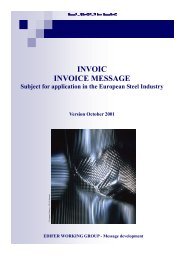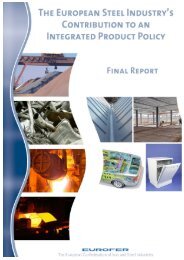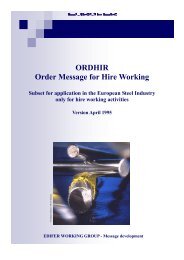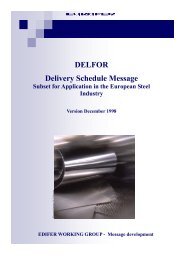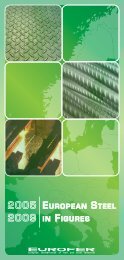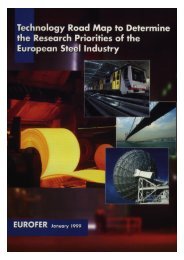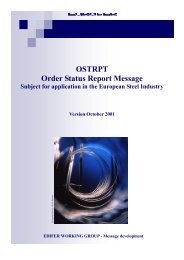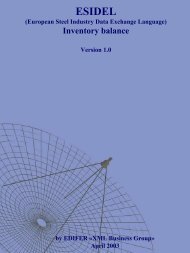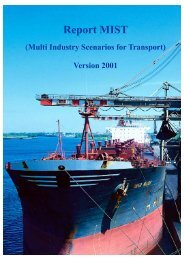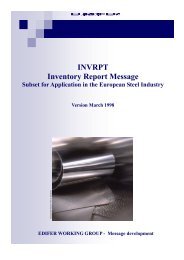manufacture, processing and use of stainless steel - International ...
manufacture, processing and use of stainless steel - International ...
manufacture, processing and use of stainless steel - International ...
Create successful ePaper yourself
Turn your PDF publications into a flip-book with our unique Google optimized e-Paper software.
hot rolling mills, <strong>stainless</strong> <strong>steel</strong> foundry 12 , <strong>and</strong> maintenance). Expected numbers <strong>of</strong> deaths<br />
were based on national mortality rates, adjusted for sex, age <strong>and</strong> calendar period. Overall<br />
mortality was close to expectation (Observed 452, Expected 434.7, SMR 104, 95% CI 95 to<br />
114). There were no significant mortality excesses for any cancer site. For lung cancer<br />
mortality, there was a non-significant increase (Observed 39, Expected 29.6, SMR 132, 95%<br />
CI 94 to 180). When lung cancer mortality data were analysed according to the workshop<br />
where subjects were employed, the only significant increase was in workers employed in the<br />
<strong>stainless</strong> <strong>steel</strong> foundry (Observed 11, Expected 4.8, SMR 229, 95% CI 114 to 409). In this<br />
group <strong>of</strong> workers, the greatest excess lung cancer mortality occurred in workers with at least<br />
30 years since first employment (SMR 324, 95% CI 119 to 705). Lung cancer mortality<br />
among ferroalloy production workers was less than expected (Observed 2, Expected 3.0, SMR<br />
68, 95% CI 80 to 245), among workers from the <strong>stainless</strong> <strong>steel</strong> melting <strong>and</strong> casting workshops<br />
was close to expectation (Observed 7, Expected 6.7, SMR 104, 95% CI 42 to 215), <strong>and</strong> in the<br />
hot rolling mills workshops showed a non-significant increase (Observed 17, Expected 11.3,<br />
SMR 151, 95% CI 88 to 242). For all workshops combined, lung cancer mortality did not<br />
show any relationship with either time since first exposure or duration <strong>of</strong> employment. No<br />
exposure data were provided in this study. It was reported, however, that in some <strong>of</strong> the<br />
workshops, including the <strong>stainless</strong> <strong>steel</strong> foundry, exposure to PAHs may occur, originating<br />
from moulds <strong>and</strong> cores, in addition to exposure to metal fumes.<br />
Overall, in this study, no elevated lung cancer risk was apparent for workers involved in the<br />
<strong>stainless</strong> <strong>steel</strong> production (melting shop) process. The study provides some evidence <strong>of</strong><br />
increased lung cancer risk in workers in a <strong>stainless</strong> <strong>steel</strong> foundry which was integrated into a<br />
<strong>stainless</strong> <strong>steel</strong> production plant, but provides little indication as to causative agent(s). It should<br />
be noted that “iron <strong>and</strong> <strong>steel</strong> founding” is considered by IARC to be a Group 1 carcinogenic<br />
activity (IARC, 1984 & 1987). There is no definitive identification <strong>of</strong> the carcinogenic agents<br />
by IARC. PAHs, silica, phenol, isocyanates, various amines <strong>and</strong> formaldehyde (apparently<br />
arising from the materials added to the foundry s<strong>and</strong>, including organic binders) <strong>and</strong> "metal<br />
fumes" are suggested as possibilities. The carcinogenic agents are not apparently specific to<br />
the metals being cast. It should also be noted that, in Europe, only a very small number <strong>of</strong><br />
people is now employed as <strong>stainless</strong> <strong>steel</strong> foundry workers.<br />
Summary <strong>of</strong> epidemiological investigations<br />
Epidemiological studies <strong>of</strong> cancer mortality among <strong>stainless</strong> <strong>steel</strong> production workers are<br />
summarised in Table 2.2. These studies do not provide convincing evidence <strong>of</strong> elevated lung<br />
cancer risk in workers involved in <strong>stainless</strong> <strong>steel</strong> <strong>manufacture</strong>. In one <strong>of</strong> the studies,<br />
information was provided on excess lung cancer risk in <strong>stainless</strong> <strong>steel</strong> foundry workers.<br />
12 In this study, foundry operations were integrated into the <strong>stainless</strong> <strong>steel</strong> production process <strong>and</strong> the<br />
foundry was located in the same plant. Foundry operations are not strictly part <strong>of</strong> the production<br />
process <strong>and</strong>, in the modern industry, it would be more appropriate to consider them under "<strong>stainless</strong><br />
<strong>steel</strong> <strong>processing</strong>".<br />
37



